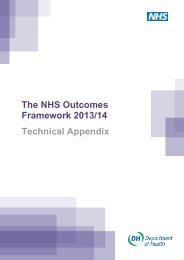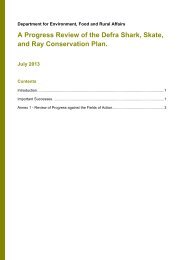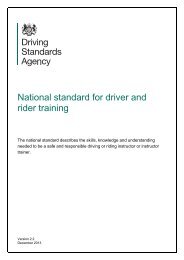Decontamination in primary care dental practices - Gov.uk
Decontamination in primary care dental practices - Gov.uk
Decontamination in primary care dental practices - Gov.uk
Create successful ePaper yourself
Turn your PDF publications into a flip-book with our unique Google optimized e-Paper software.
<strong>Decontam<strong>in</strong>ation</strong>: Health Technical Memorandum 01-05 – <strong>Decontam<strong>in</strong>ation</strong> <strong>in</strong> <strong>primary</strong> <strong>care</strong> <strong>dental</strong> <strong>practices</strong> (2013 edition)developed protocols and procedures <strong>in</strong>place to prevent contam<strong>in</strong>ation of these<strong>in</strong>struments by ensur<strong>in</strong>g that thoserequired for a particular patient areremoved from their protected environmentbefore treatment commences. Thiselim<strong>in</strong>ates the need to open cupboarddoors or drawers dur<strong>in</strong>g patient treatment.If an <strong>in</strong>strument does need to be retrievedfrom a cupboard or drawer dur<strong>in</strong>gtreatment, the practice should haveprotocols <strong>in</strong> place to preventcontam<strong>in</strong>ation and to ensure that staffhands are clean and that new gloves aredonned before handl<strong>in</strong>g unwrappedsterilized <strong>in</strong>struments. Regard all<strong>in</strong>struments set out for each patient ascontam<strong>in</strong>ated after the treatment whetheror not they have been used.Instruments that are kept unwrapped should bereprocessed at the end of the work<strong>in</strong>g day,regardless of whether they have been used.Alternatively, <strong>in</strong>struments can be reprocessed atthe beg<strong>in</strong>n<strong>in</strong>g of the next work<strong>in</strong>g day.(iii) Unwrapped <strong>in</strong>struments <strong>in</strong> a non-cl<strong>in</strong>icalarea: maximum storage 1 week.Non-cl<strong>in</strong>ical area <strong>in</strong> this context isdesignated as a cl<strong>in</strong>ical area not <strong>in</strong> currentuse or <strong>in</strong> a clean area of a separatedecontam<strong>in</strong>ation room. Instruments shouldstill be stored as follows:• dry; and• protected from contam<strong>in</strong>ation, forexample <strong>in</strong> m<strong>in</strong>i-racks placed <strong>in</strong>cupboards, or <strong>in</strong> covered drawer <strong>in</strong>serts.Instruments should not be placed on openwork surfaces.m. Develop a quality system approach so that thestorage of wrapped <strong>in</strong>struments does not exceedone year.n. Equipment used to decontam<strong>in</strong>ate <strong>dental</strong><strong>in</strong>struments should be fit for purpose andvalidated. This means that the device should becommissioned, ma<strong>in</strong>ta<strong>in</strong>ed and periodicallytested by a Competent Person(<strong>Decontam<strong>in</strong>ation</strong>) or service eng<strong>in</strong>eer, thatrecords of ma<strong>in</strong>tenance should be kept and thatcorrect function<strong>in</strong>g should be monitored andrecorded (see Section 3).Notep. The appropriate and controlled disposal ofwaste is a key aspect of risk control <strong>in</strong> local<strong>dental</strong> <strong>practices</strong> (see Section 3).q. A documented tra<strong>in</strong><strong>in</strong>g protocol should be <strong>in</strong>operation with <strong>in</strong>dividual tra<strong>in</strong><strong>in</strong>g records for allstaff engaged <strong>in</strong> decontam<strong>in</strong>ation (see Section 3for details).r. The practice should carry out an assessment ofthe changes needed to move from compliancewith essential quality requirements tocompliance with best practice requirements.s. Staff <strong>in</strong>volved <strong>in</strong> decontam<strong>in</strong>ation shoulddemonstrate current immunisation for hepatitisB and, subject to local policy, tetanus. Staffmust be <strong>in</strong>formed of the benefits (for exampleprotection aga<strong>in</strong>st serious illness, protectionaga<strong>in</strong>st spread<strong>in</strong>g illness) and drawbacks (forexample reactions to the vacc<strong>in</strong>e) of vacc<strong>in</strong>ation.Vacc<strong>in</strong>ation is considered additional to, and not asubstitute for, other control measures.t. The effective clean<strong>in</strong>g of handpieces <strong>in</strong>accordance with manufacturers’ guidance.Dedicated clean<strong>in</strong>g equipment is availableand may be of value. However, validation<strong>in</strong> this area is difficult, and the advice ofmanufacturers/suppliers should be sought.u. Separate wash-hand bas<strong>in</strong>s for use by staffconduct<strong>in</strong>g decontam<strong>in</strong>ation should beprovided.v. Wash<strong>in</strong>g and r<strong>in</strong>s<strong>in</strong>g of <strong>in</strong>struments can beachieved by:• Two dedicated s<strong>in</strong>ks with a separate orshared water supply.• One s<strong>in</strong>k with a removable bowl, whichcan be conta<strong>in</strong>ed with<strong>in</strong> the s<strong>in</strong>k that canaccommodate the <strong>in</strong>struments for r<strong>in</strong>s<strong>in</strong>g.This is the least preferred option as itrequires lift<strong>in</strong>g and mov<strong>in</strong>g bowls ofcontam<strong>in</strong>ated water with associatedspillage risks. The practice should haveclear processes and protocols <strong>in</strong> place toensure that the removable bowl is not usedfor the wash<strong>in</strong>g of <strong>in</strong>struments.These s<strong>in</strong>ks should not be used for hand-wash<strong>in</strong>g.12
















